Houses and
Grandstands: Henry Norrisí Architects
Last
updated: February 2009
CHISWICK PARK
The younger
Harrington, Llewellyn Harry, was born in 1883.
Iíve said above that when his mother was widowed he was still
living at
home; he was probably doing his architecture and surveying training at
the
time, or moved to Bromley to begin it.
Unlike William, Llewellyn did become FRIBA.
In 1910 he married Eliza Hillier, a woman
from West Ham where the Harringtons may have had cousins.
Llewellyn may have been working for KPEC before
1915 but I have no evidence of it before that year and some evidence to
suggest
the opposite: although William and his wife attended the Norrisesí
reception at
Fulham Town Hall, given in March 1913, Llewellyn and his wife didnít. Thereís plenty of evidence that Llewellyn
worked for KPEC from 1915 to the mid-1930s
William Harringtonís death in 1930 led to the closing of KPECís
offices
in Burnt Ash Lane Plaistow, Llewellyn preferring to work from an
address in
Croydon. Despite working for KPEC for 20
years, Llewellyn still didnít seem to have known either William Gilbert
Allen
or Henry Norris very well: he didnít go to or send a wreath to either
of their
funerals.
The land on which KPEC
built the Chiswick Park estate was bought in 1928.
Design work for the estate, including the new road called Kinnaird Avenue, began straight away and the first planning
applications were made in 1929.
Brentford and Chiswick UDC is satisfied, based on the drawings
that went
with the original planning applications, that Llewellyn Harrington did
all the
design work for KPECís housing estate at Chiswick Park.
I havenít seen the actual planning
applications, just the Council Minutes so Iím certainly not going to
argue with
the Councilís conclusions. However, I
will say that until July 1930, all KPECís applications were in the
Minutes with
William Harringtonís name on them. I
would take that to mean that although Llewellyn was doing the designs
for the
estate William, as the senior man in the firm, was signing them off. After Williamís death (1930) the Minutes list
applications from KPEC with no name at all, all except for Ellesmere Road
(1931) which is listed as from Llewellyn
Harrington.
KPEC built three kinds
of properties on the estate:
-
semi-detached houses: in Devonshire Gardens, Grove Park Road, Hartington
Road
and Kinnaird Avenue
-
maisonettes; and I detect the
hands of William Gilbert Allen and Henry Norris here, even down to the
maisonettes being designed as a variation on a house: Devonshire Gardens and
Grove Park Road
-
detached houses: 59 and 61 Hartington Road, the second of which is something rather
special.
Each of the plots was
generously-sized. The rooms in the
properties are large and the front gardens are bigger than anything
KPEC built
at Bickley. You can see all the actual
addresses
in the files on KPEC Chiswick.
Building began in
1929, slowed up a bit in the early 1930s for obvious reasons, but was
completed
by 1935.
The list and
discussions below are based on a visit Roger and I made to Chiswick Park to
look at the properties on the ground. We
were plagued by downstairs rooms turned
into garages; and also by the original applications of one or two
properties
which were changed half-way through the design process to incorporate a
garage
when built. It was not always easy to
tell which type of garage was which.
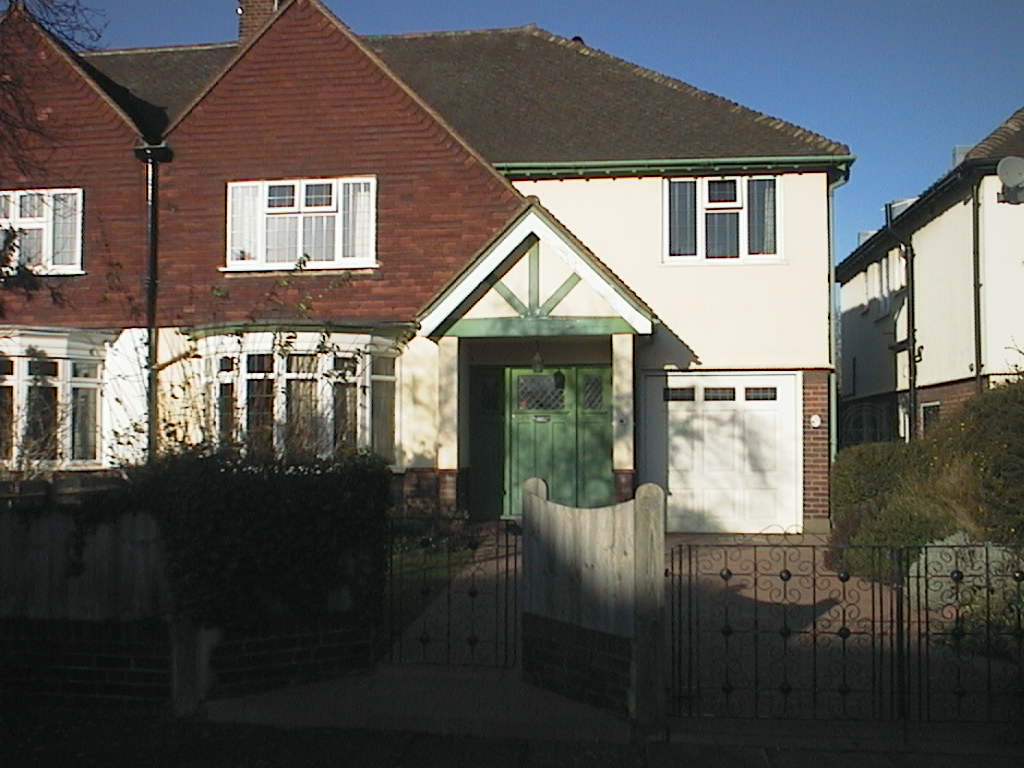
24 Devonshire Gardens
was part of the first group of houses built on the Chiswick Park
Estate:
1929-30. As photographed, it has an
integral garage that I think was once the dining room.
Other features of the house are still as
built, with variations on the Bedford Park themes used on KPECís
properties at
Bickley. One change from Bickley,
though, is the incorporation of two gables into the design, making
interesting
features at the cost of a more complicated roof construction; itís
something
you can see elsewhere on the estate. 24
Devonshire Gardens has two gables. One
is a dominating feature, steep and wide and clad in dark wood; it has
an attic
room in it. The other is over the porch,
smaller (obviously) but echoing the bigger oneís sharp angle. The part of the house above the porch is
white-painted render to make a contrast with the wood cladding and the
red-brown bricks at ground level.
Another big break with
what was normal at Bickley is the abandonment of the double-height bay. 24 Devonshire Gardens has a bay on the ground
floor only. Itís
design is different from anything at Bickley, too: each window is at a
slight
angle to the next, creating a shallow, angled semi-circle.
The attic window above it is flat to the
front of the gable. The houseís smaller
details are more like Bickley however: the idea of a three-part front
door in
the porch - central door with wooden panels either side, with windows
at the
top of all three; the division of the windows into a small pane at the
top with
a long pane below; the chimneys used as a design feature.
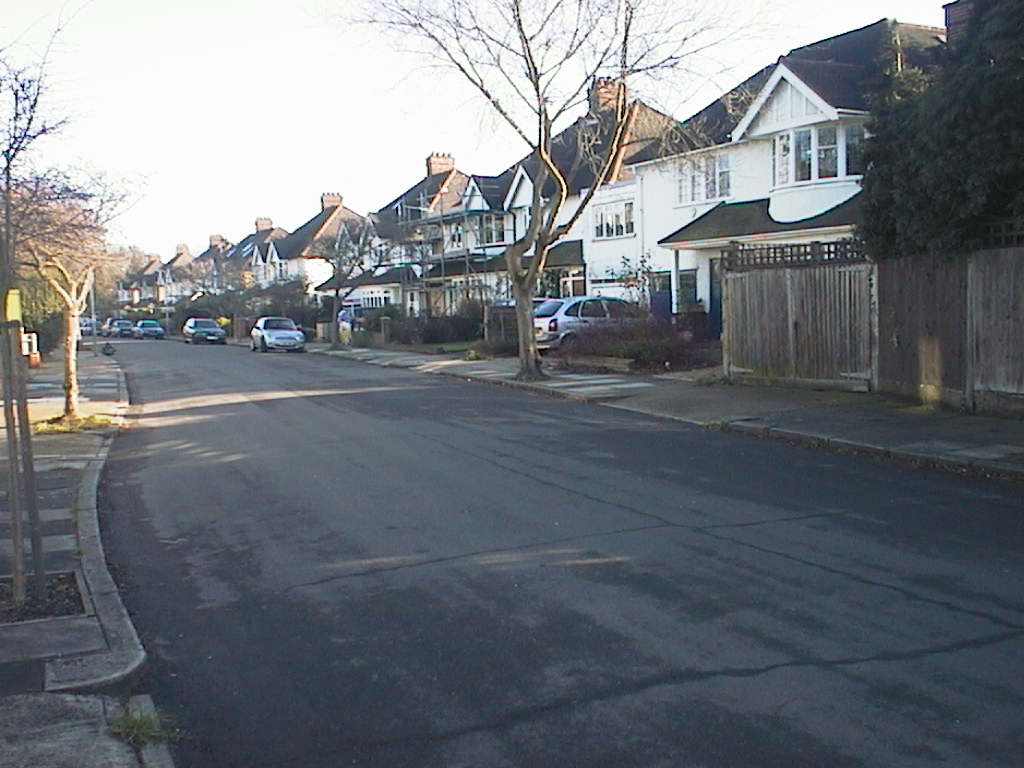
This is a long view of
Kinnaird Avenue though please note that the nearest house is not by
KPEC. Kinnaird Avenue was the only
completely new
street on the estate. All the houses in
it were built to the same design, in 1930-1931.
In its Report on the estate, Brentford and Chiswick UDC
particularly
mentioned the design of the roof as an interesting feature. Essentially itís in three parts: a
turret-type structure above the front door and first-floor room, and a
gable
above a small first-floor bay jutting out from the main steep slope. Thereís more roof tiling below the first-floor
bay.
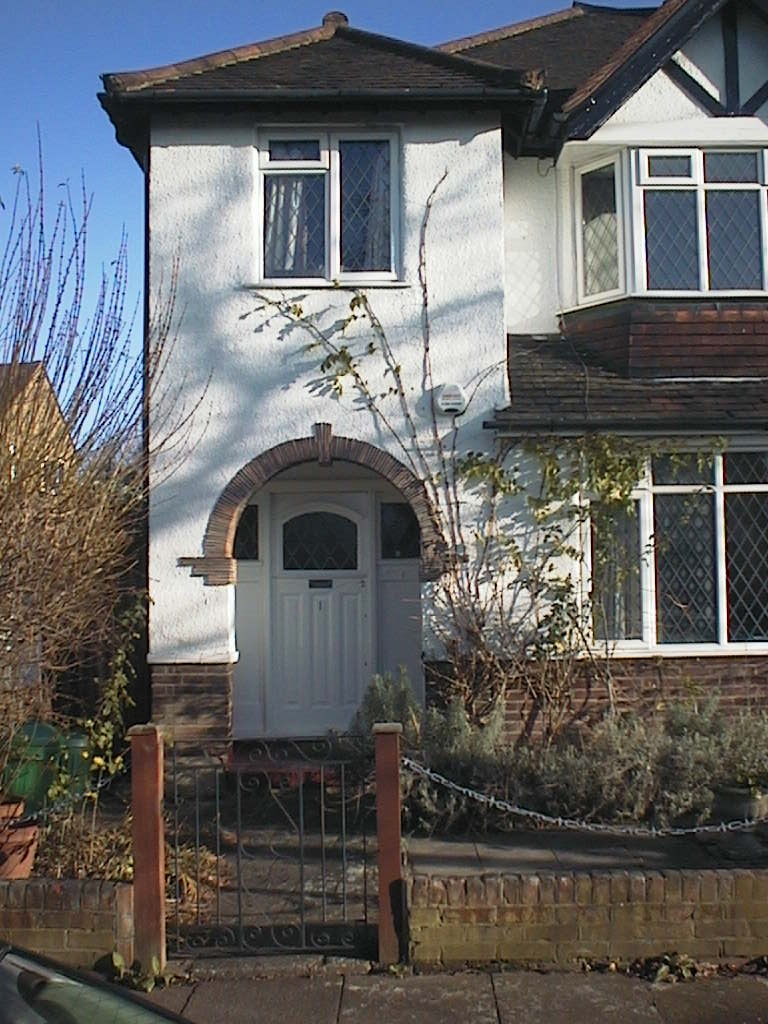
2 Kinnaird Avenue had
its original front door, we thought: deeply inset into the porch, again
in
three parts with leaded windows at the top of each part.
Part of KPECís
purchase for their Chiswick Park Estate was a site on Hartington Road
which
included two boat yards on the Thames, the land behind them and enough
land on
the other side of the roadway to build two sets of houses opposite each
other;
plus two detached houses beyond number 57.
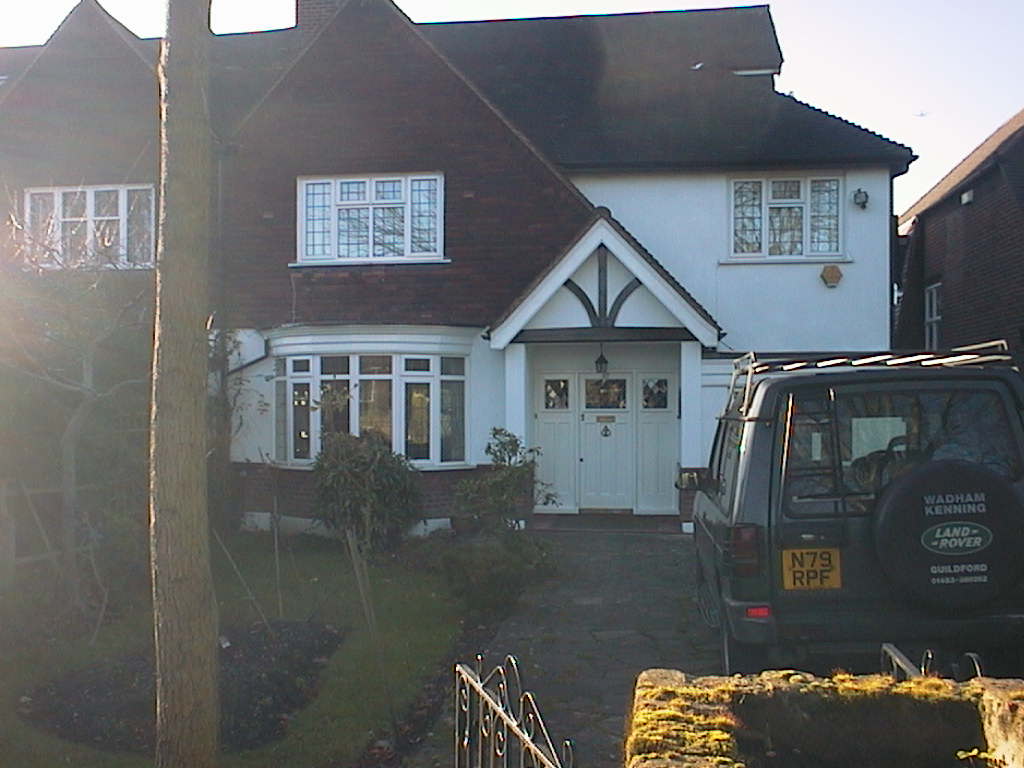
57 Hartington Road is
at one end of the row on the river side of the street.
Both rows were built in 1931-32. At
57 thereís another integral garage that I
bet wasnít there to start with. The
design used for all the houses in the two rows has the same
wood-cladded gable
above an angled ground-floor bay; and white-painted render above the
rest of
the frontage to contrast, as the houses in Devonshire Road. It also has a similar porch to the Devonshire
Garden design, although more imposing.
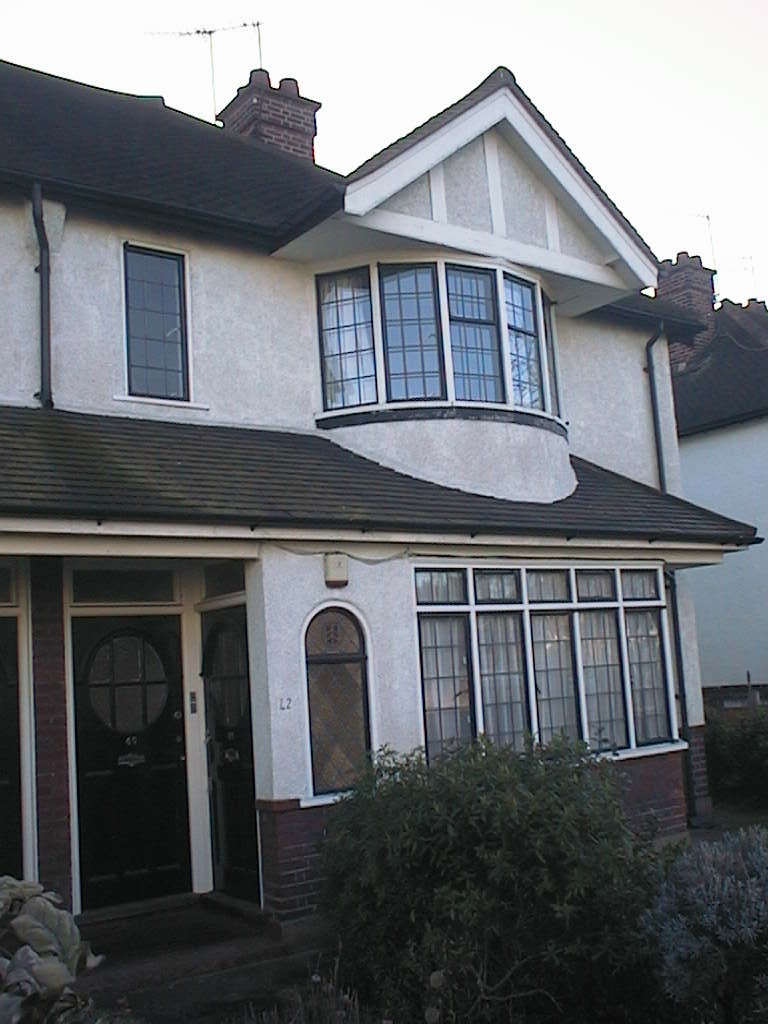
40-42 Grove Park Road
is a set of two maisonettes with front doors at right-angles, next to
and
opposite the doors to 36-38. The windows
still have the original metal frames. A
long roof of brown tiles runs from 36 to 42 above the two front rooms
of the
downstairs maisonettes. Above the roof
each top floor maisonette has one of the shallow, angled bays used all
over the
estate; with a steep-sided gable on top of it.
The first floor is white-painted render.
This group of 12 maisonettes was built in 1932-33.
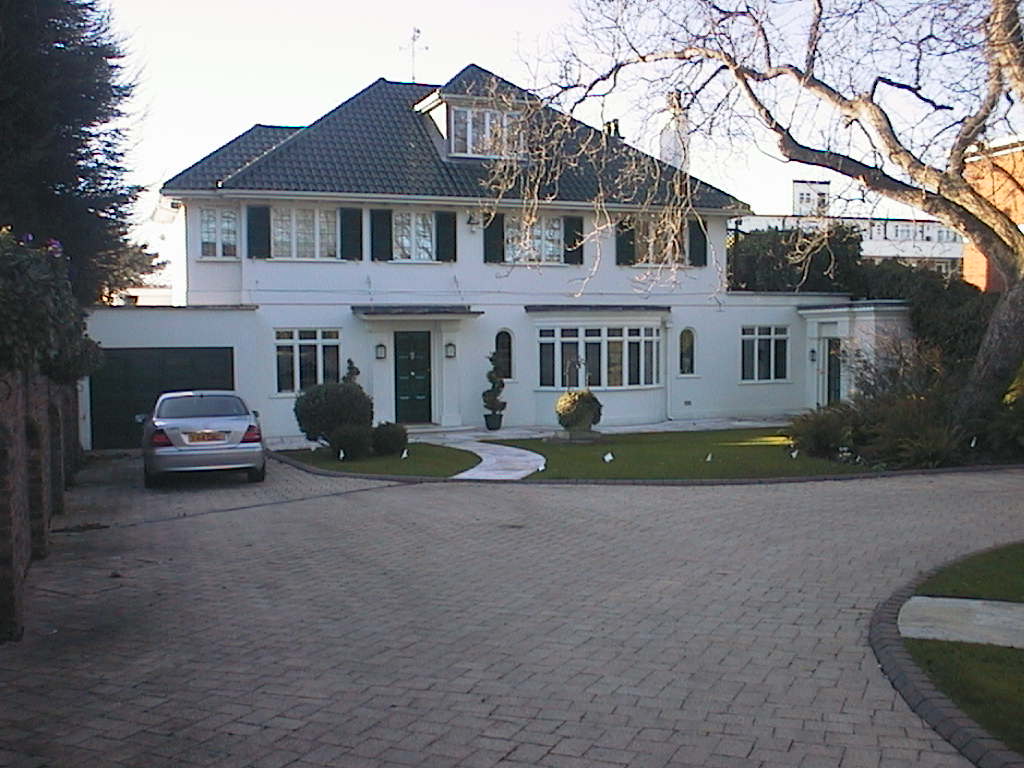
61 Hartington Road is
Chiswick Park Estateís piŤce de rťsistance.
The planning application went in in December
1931 but no one was living in the house before 1935 so the actual
building of
it was probably held up by the grim economic times.
Brentford and Chiswick UDCís Report on the
estate mentioned particularly the buildingís pantiles, which (the
Report
thought) gave the house a Mediterranean feel; Iíd add to that the way
all the
brick-work (at least, all that you can see from the road) is painted
white.
Ignoring the large
amount of paving in front of the house, which Iím sure is modern, Iíve
debated
endlessly whether the garage is original; and I think the small room at
the far
right (of the photograph that is), with a second front door at
right-angles to
the main one, is new too, though unobtrusively done.
I shall therefore ignore these doubtful parts
of Llewellyn Harringtonís design to say how nice the rest is, and how
different
from everything else on the estate: no bays, no porch only a
cantilevered
overhang above the front door; there are no gables at the front, though
the
roof is a complex design suggesting that the frontage on the river side
(round
the back in this photograph) may look completely different; and just
the
contrast of the white walls with the brown tiles on the roof to liven
up the
roadside frontage. I think the design is
a break with the influence of Bedford Park and shows that Llewellyn
Harrington
was keeping up to date with changes in design style: in that straight
frontage
you can see a hint of the Bauhaus; the way the room at the right
disturbs the
straight frontage is the reason why I believe it may be a later
addition.
59 and 61 Hartington
Road, and the maisonettes on Grove Park Road, were the last properties
built by
KPEC at Chiswick Park and with them the estate was complete. On small sites a short distance from the
estate, KPEC built two houses on Sutton Court Road (1932); and two
maisonettes
on Ellesmere Road (1933) originally designed as one house but rejected
in that
form by the Council, which had scheduled the street for flats only. When the Ellesmere Road properties and 61
Hartington Road were finished, KPEC wound itself up and (I suppose)
Llewellyn
Harrington moved on to other contracts.
[ROGER THE LAST IN
THIS SEQUENCE IS SLLEITCH]
IF YOU WANT TO KNOW
MORE ABOUT THE SOURCES OF ALL THIS INFORMATION, SEND ME AN EMAIL AND
IíLL SEND
YOU THE SOURCES FILE.
Copyright Sally Davis January
2009
***





